 Mike Akana’s love for fitness was discovered while playing baseball for Boise State University. He had developed two possible paths during this time of his life; one, he could pursue medicine, or; two, he could pursue preventative medicine in the form of personal training and exercise.
Mike Akana’s love for fitness was discovered while playing baseball for Boise State University. He had developed two possible paths during this time of his life; one, he could pursue medicine, or; two, he could pursue preventative medicine in the form of personal training and exercise.
The second posed a much greater outreach for Akana. He spent eight years in the industry working different aspects, such as personal training, fitness manager, cross fit director and as VP of fitness.
In July, Akana opened the Torque Performance Center inside Gold’s Gym Birmingham in Birmingham, Ala. “The placement of our facility inside the Gold’s Gym is crucial to the company’s success,” Akana said. “Gold’s provides us with a membership base to generate business. It also eliminates heavy fixed costs, such as rent. They keep the overhead down and revenue up.”
Akana has employed several top-notch coaches within the Torque Performance Center. Lewis Sanders played in the NFL for nine years; Jeff Carpenter was a running back at Boise State and had two bowl championships and two undefeated seasons. Steven Johnson is a part time chiropractor and a part-time performance coach.
The center focuses on aspects away from the typical gym.
“Typical gyms focus on machines and equipment and control the movement of the body, where we focus on the body controlling the movement of the exercise,” Akana explained. “Our training programs are all based on functional, multiplanar exercises that help the members work on their ‘go muscles’ instead of their ‘show muscles.’
“We accomplish this through trial and error and started with just three classes per day. We add more classes based on space. This concept has worked very well for the coaches, members and company.”
Torque has relied mainly on word of mouth advertising. “Traditional gyms spend large amounts of money on billboards, radio spots, etc.,” Akana said. “Most of our advertising is done through our members. Members bring friends in for free to try out the class. Members get free t-shirts for referring a guest and the environment it creates is incredible.
“Our group classes are also unique because it combines a group exercise class model with a one-on-one personal training model. The workouts are prewritten on a white board in the performance center and members come in during the class hour, warm up with the performance coach and do the workout on the board while the performance coach walks around and provides guidance, correction, motivation and information about the workout.”
Unlike typical personal training classes, Torque doesn’t comp employees per session. “We are paying our coaches off a membership-dues base,” Akana said. “This was tricky because if you pay a coach an hourly rate on a class and there are 30 classes a week with only 50 members, the profit margins are in the negative. However, if you have the same hourly wage and the same amount of classes, the profit margins are extremely high.
“We had to figure out how we could pay the coaches to incentivize growing our EFT dues on a monthly basis. We figured this out by creating a commission based on the number of members enrolled. For example, zero to 99 members would result in a $5 per hour wage increase, 100 to 199 members a $10 per hour wage increase, etc.”
The classes are spread out into several different categories — speed training, functional training, adult classes, youth classes, strength training for athletes and corrective exercise.
At Torque Performance Center, customer service is rarely an issue because of the constant interaction members have with the trainers. The amount of interaction helps members stay on top of workouts and continually gives the coaches a high success rating from their members. -CS








